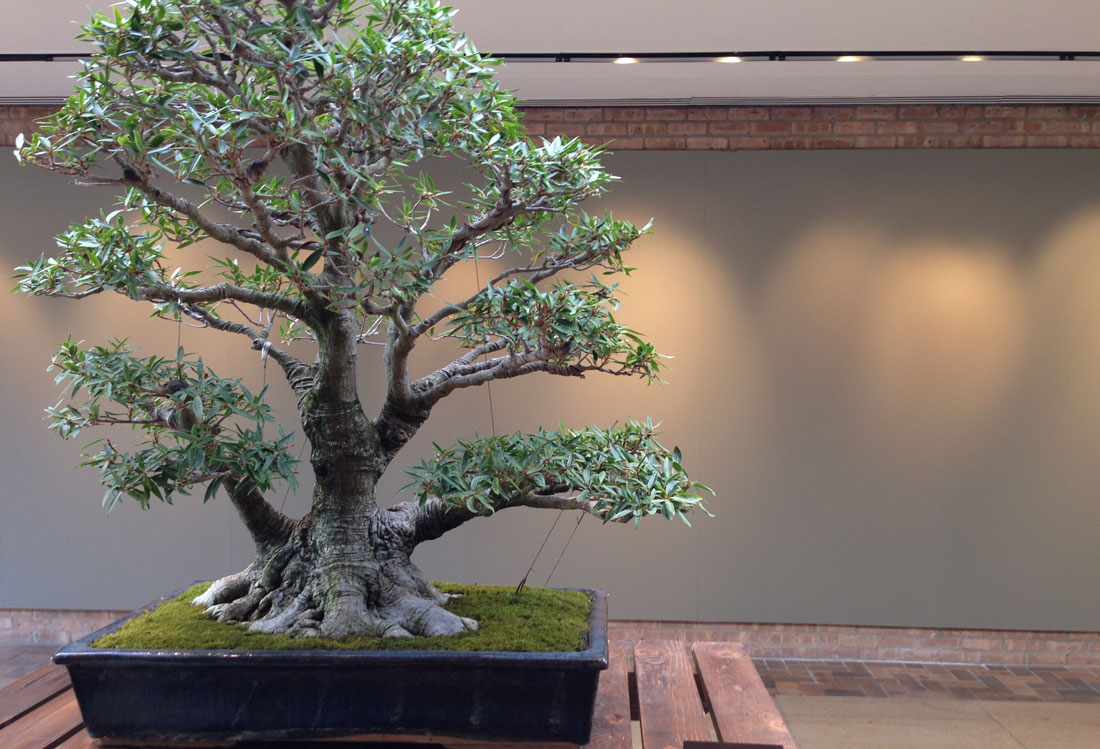By Claire Donnelly
Chris Baker has 269 children.
His children are green, grow leaves and live at the Chicago Botanic Garden. They’re bonsai trees.
“[They] take a lot of care,” said Baker, who tends to more than 150 different species as the bonsai curator at the
Chicago Botanic Garden. Baker and nine community volunteers water and prune trees daily, part of the ancient art form and horticultural practice of bonsai.
And what is bonsai?
The rough translation is “tree in a tray” or “tree in a container,” said Baker. But the word is used in multiple ways. “We use it to refer to the actual tree itself, [and we also] use it to refer to the art form of creating those trees,” Baker added.
And, in case you are wondering, the plural form of “bonsai” is “bonsai.”

Baker explained bonsai can be created from different species of trees, but the art and skill lies in training a tree to grow in a specific and sculptural form using wiring, root pruning, and other techniques.
“The training process is part horticulture, part mechanically manipulating the tree, and it’s also part design and style,” Baker said. Essentially, the idea is to cultivate a tree in a tray that looks like a tree that could be found in nature. “A tree should take you to a place,” Baker added.
Susan Babyk, a board member of the Midwest Bonsai Society, said, “It’s like shrinking nature and bringing it indoors. … It’s a miniature landscape that you can keep [inside].”
Baker has been honing his bonsai skills for about 13 years. In 2012, he spent six months in Japan, where he studied under a bonsai master and lived at a nursery. The master followed traditions on nurturing bonsai that are centuries old.

When he returned to the U.S., Baker volunteered at the National Arboretum in Washington, D.C.
Many of the bonsai that Baker cares for at the botanic garden are hundreds of years old. The oldest bonsai are between 150 and 200 years old and were donated to the garden in 2000 by a Japanese bonsai master.
Baker also tends to a pine that is estimated to be as many as 800 years old, but it has only been training as a bonsai for 35 or 40 years.
“There’s so much history in bonsai,” Baker said. “I get to maintain the trees now … and hopefully improve upon them with each year, but I’m just one person in a line of people that have cared for these trees.”
Quick guide to growing tiny trees
- Start small.
Begin with one or two tree species you already know how to care for or teach yourself how to care for just one new species. Focus on caring for those one or two trees and keeping them healthy. Your trees will respond more favorably to manipulation and bonsai training if they’re already happy and thriving. “Tree health [is] first and foremost,” said Chris Baker, bonsai curator at the Chicago Botanic Garden. - Know your resources.
Be honest with yourself about the amount of time you will commit to cultivating a bonsai and keep this in mind when selecting a tree species. For outdoor trees, keep your yard conditions in mind—don’t buy a tree species that loves shade if your outdoor space is bright and sunny. Also, make sure you have a cool, dark place to store outdoor bonsai during the winter months when the trees are dormant. - Read up.
Susan Babyk, a board member of the Midwest Bonsai Society, recommends Simon & Schuster’s Guide to Bonsai. She said it contains useful information for beginners as well as lots of photographs. “Everybody has this one,” she said. - Find fellow bonsai lovers.
Looking for pruning advice or other bonsai tips? Take a bonsai class with Baker at the Chicago Botanic Garden or get involved with the Midwest Bonsai Society. There are plenty of other bonsai groups around the Midwest with experts who can help you develop your hobby.
Information compiled from interviews with Chris Baker and Susan Babyk.
Bonsai have a reputation for being labor-intensive plants to maintain. “They certainly require more care than your average potted houseplant,” Baker said. “The container size and the soil itself is what makes them tricky. They’re [generally] very hearty trees.”

According to Baker, bonsai grow best in soil that is loose and drains well, and the plants are usually grown in shallow trays rather than deep pots. This means bonsai trees need more frequent watering, which can be difficult for a casual—or forgetful—home gardener.
“They keep me busy,” laughed Babyk, who has more than a dozen outdoor and indoor bonsai at her home. “I don’t think of it as work. I think of it as pure pleasure,” she added.
Baker agreed. “It’s a labor of love,” he said. “They do require some care, but it should be enjoyable, ultimately.”

